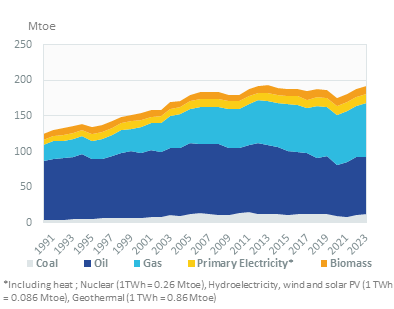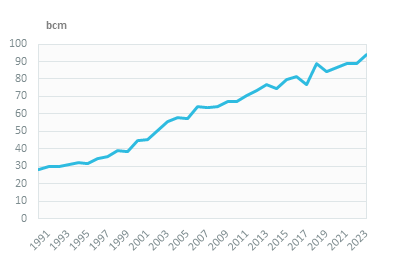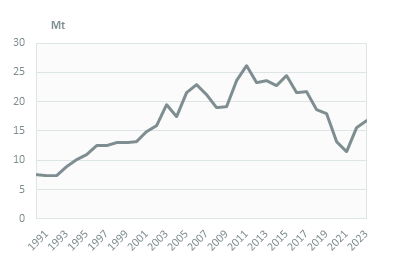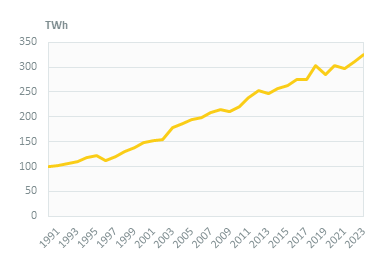-
-
 Energy and Climate Databases
Energy and Climate Databases- The most comprehensive and up-to-date annual energy database.
- Monitoring of technology providers in H2 supply chain.
- Monthly energy data on key energy markets.
- The most reliable and up-to-date power generation database.
- The essentials of LNG trade at your fingertips.
- Global monitoring of new and existing refineries.
- Analyse energy consumption and efficiency trends at world level. Benchmark countries.
- Have your database developed by a recognised expert of both energy and IT.
-
 Energy - Climate Forecasts
Energy - Climate Forecasts- Instant access to energy and emissions forecasts.
- Strategic, annual wholesale price projections backed by Enerdata's energy modelling expertise and our globally recognised POLES model.
- Wedges module showing a breakdown of the levers enabling to reduce emissions between two scenarios.
- Unique, independent projections of consumption by end-use.
- GHG Marginal Abatement Cost Curves.
- Benefit from proven models to draw your own energy scenarios and anticipate tomorrow’s challenges.
-
 Market Intelligence
Market Intelligence- 110 Energy and climate country reports
- A newsletter to receive the latest updates on evolving technologies and policies.
- Global energy news and analyses curated daily.
- Enerdata’s experts bring you the essentials about your market and competitors.
-
-
-
 Market Analysis
Market Analysis- Understanding key consumption trends and drivers across sectors.
- Granular and exclusive insight to address the most pressing business and strategic issues.
- Expertise in strategic and business intelligence, with fine-tuning to the market’s specificities.
-
 Energy - Climate Scenarios
Energy - Climate Scenarios- Providing the outlook of an energy commodity in mid to long term time horizons.
- Sector and driver specific energy demand forecasting.
- Assess the evolution of energy prices on the international and regional markets, as well as end-users prices.
- Enerdata guides you through pathways to reach climate targets.
- Supporting local authorities in their decarbonisation strategies.
-
 Climate Strategy and Policy Evaluation
Climate Strategy and Policy Evaluation- Cutting-edge quantitative tools and relevant indicators to monitor and evaluate evolutions on worldwide energy markets.
- Analysis of the most cost-effective options to reduce emissions.
- Quantified simulation and analysis of pledges for climate change negotiations.
- Breakdown and analysis of carbon markets.
- Enerdata guides you on the most beneficial policy or investment options.
- Turning climate objectives into concrete action plans.
-
 Training
Training- Understand different policy targets and measures on energy efficiency.
- How to measure energy savings?
- Energy Forecasting is a 2 days training to learn to design and interpret energy forecasts.
- Energy statistics training allowing to create energy balance with supply, transformation and consumption and understanding the international energy statistics regulations.
- Initiation to EnerMED level 1is the training to approach on the most powerful energy demand forecasting model.
-
-
Resource Centre
Mexico Key Figures
- Population:
- 128 million
- GDP growth rate:
- 3.07 %/year
- Energy independence:
- 78.4%
Data of the last year available: 2022
- Total consumption/GDP:*
- 78.7 (2005=100)
- CO2 Emissions:
- 3.43 tCO2/capita
- Rate of T&D power losses:
- 13.3%
* at purchasing power parity
View all macro and energy indicators in the Mexico energy report
Mexico Related News
View all news, archive your new and create your own daily newsletters only on your topics/countries of interest with Key Energy Intelligence
Mexico Related Research
Benefit from up to 2 000 up-to-date data series for 186 countries in Global Energy & CO2 data
A data overview is available in the global energy statistics app
Total Energy Consumption
Total energy consumption per capita is 1.5 toe and electricity consumption per capita reached around 2 200 kWh (2022).
Total energy consumption increased by 2.5% in 2022 to 188 Mtoe, following a 5% rebound in 2021 after the COVID-19 pandemic. Previously, it had been decreasing slightly over 2013-2019 (by 0.8%/year).
Graph: CONSUMPTION TRENDS BY ENERGY SOURCE (Mtoe)

Interactive Chart Mexico Total Energy Consumption
Benefit from up to 2 000 up-to-date data series for 186 countries in Global Energy & CO2 data
View the detailed fondamentals of the market at country level (graphs, tables, analysis) in the Mexico energy report
Crude Oil Production
Oil production has been stable at around 95 Mt since 2019, after a rapid decrease since a peak of 191 Mt from 2004 to 2019 (-4.6%/year). Approximately 70% of the production is extracted in the Bay of Campeche, in the south of the Gulf of Mexico (offshore). Mexico's sliding oil production is mainly explained by the decline of the Cantarell field (from 2 mb/d in 2004 to 0.16 mb/d in 2018 and no production since 2019). Around half of the production is exported (52% in 2022).
Interactive Chart Mexico Crude Oil Production
Benefit from up to 2 000 up-to-date data series for 186 countries in Global Energy & CO2 data
Additionally, for more detailed information on refineries, you can request a sample of our America Refineries Dataset
Oil Products Consumption
The consumption of oil products increased by 14% in 2022 up to 90 Mt, after a 19% rebound in 2021 and a sharp 20% drop in 2020. It had been decreasing between 2013 and 2019 with an acceleration since 2016 (-3%/year compared to -1%/year over 2013-2016). Between 2005 and 2013, it remained largely stable (around 93 Mt).
Transport represents 64% of the demand, followed by power plants (16%), industry (9%), and residential, services and agriculture (8%).
Graph: OIL CONSUMPTION (Mt)
Interactive Chart Mexico Refined Oil Products Production
Benefit from up to 2 000 up-to-date data series for 186 countries in Global Energy & CO2 data
Additionally, for more detailed information on refineries, you can request a sample of our America Refineries Dataset
Natural Gas Consumption
Gas demand has stagnated at around 92 bcm since 2020 (-2% in 2022). It increased rapidly between 2000 and 2020 (4.4%/year) with the commissioning of numerous gas power plants (+29 GW).
Graph: NATURAL GAS CONSUMPTION (bcm)

About 46% of gas demand is used by the oil and gas sector, 41% for power production, and 12% by industry (2022). Gas use in buildings (residential and services) remains marginal (1%).
Graph: GAS CONSUMPTION BREAKDOWN BY SECTOR (2022, %)
Interactive Chart Mexico Natural Gas Domestic Consumption
Benefit from up to 2 000 up-to-date data series for 186 countries in Global Energy & CO2 data
Additionally, for more detailed information on the LNG trade, you can request a sample of our America LNG Trade Dataset
Coal Consumption
The demand for coal rebounded by 25% in 2022 to 15.6 Mt, after having decreased rapidly since 2011 (-7%/year on average), with a more striking reduction in 2020 (-27%).
Power generation absorbed almost 40% of the coal consumption in 2022 (it used to be around two thirds).
Graph: COAL CONSUMPTION (Mt)

Graph: COAL CONSUMPTION BREAKDOWN BY SECTOR (2022, %)
Interactive Chart Mexico Coal and Lignite Domestic Consumption
Benefit from up to 2 000 up-to-date data series for 186 countries in Global Energy & CO2 data
View the detailed consumption trends at country level (graphs, tables, analysis) in the Mexico energy report
Power Consumption
Electricity consumption did not catch up to its pre COVID-19 level, showing a 2.5%/year since 2020 increase to 277 TWh in 2022, after a 7.5% decrease in 2020. It had increased by 2.4%/year on average over 2013-2019.
In 2022, industry's share was around 57%, followed by households (21%) and services (15%). About 99% of the population is connected to the grid.
Graph: ELECTRICITY CONSUMPTION (TWh)

Graph: ELECTRICITY CONSUMPTION BREAKDOWN BY SECTOR (2022, %)
Renewable in % Electricity Production
The General Law on Climate Change ("LGCC") set the target of a 35% share for "clean energies" (renewables, nuclear, CHP, and CCS) in total power generation in 2024 (24.5% in 2022), 37.7% in 2030, and 50% in 2050. SENER now expects to reach a share of 50% earlier, in 2034.
In May 2023, CRE extended the "clean" label to gas-fired CHP plants considered to be efficient cogeneration, as well as to power plants using hydrogen, CCS, or biosequestration or with an emission rate below 100 kgCO2/MWh.
Interactive Chart Mexico Share of Renewables in Electricity Production (incl hydro)
Benefit from up to 2 000 up-to-date data series for 186 countries in Global Energy & CO2 data
CO2 Fuel Combustion/CO2 Emissions
In its updated NDC (2022), the country increased its unconditional GHG emissions reduction target to 35% by 2030 compared to BAU levels (a reduction of 347 MtCO2eq). National resources will account for at least 30%, while 5% will be covered by international cooperation and planned clean energy financing. Emissions of black carbon should be cut by 51% below BAU by 2030. Mexico could raise its emission reduction targets to 40% (black carbon emissions to 70%) conditional to international support and financing. GHG emissions decreased by 0.4% in 2021 to 714 MtCO2eq.